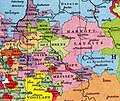House of Ascania
The Ascanians are named after Ascania (or Ascaria) Castle, known as Schloss Askanien in German, which was located near and named after Aschersleben.[2][3] The castle was the seat of the County of Ascania, a title that was later subsumed into the titles of the princes of Anhalt.
The earliest known member of the house, Esiko, Count of Ballenstedt, first appears in a document of 1036. He is assumed to have been a grandson (through his mother) of Odo I, Margrave of the Saxon Ostmark. From Odo, the Ascanians inherited large properties in the Saxon Eastern March.
Esiko's grandson was Otto, Count of Ballenstedt, who died in 1123. By Otto's marriage to Eilika, daughter of Magnus, Duke of Saxony, the Ascanians became heirs to half of the property of the House of Billung, former dukes of Saxony.
Otto's son, Albert the Bear, became, with the help of his mother's inheritance, the first Ascanian duke of Saxony in 1139. However, he soon lost control of Saxony to the rival House of Guelph.
Albert inherited the Margraviate of Brandenburg in 1157 from its last Wendish ruler, Pribislav, and he became the first Ascanian margrave. Albert, and his descendants of the House of Ascania, then made considerable progress in Christianizing and Germanizing the lands. As a borderland between German and Slavic cultures, the country was known as a march.
In 1237 and 1244, two towns, Cölln and Berlin, were founded during the rule of Otto and Johann, grandsons of Margrave Albert the Bear. Later, they were united into one city, Berlin. The emblem of the House of Ascania, a red eagle and bear, became the heraldic emblems of Berlin. In 1320, the Brandenburg Ascanian line came to an end.
After the Emperor had deposed the Guelph rulers of Saxony in 1180, Ascanians returned to rule the Duchy of Saxony, which had been reduced to its eastern half by the Emperor. However, even in eastern Saxony, the Ascanians could establish control only in limited areas, mostly near the River Elbe.
In the 13th century, the Principality of Anhalt was split off from the Duchy of Saxony. Later, the remaining state was split into Saxe-Lauenburg and Saxe-Wittenberg. The Ascanian dynasties in the two Saxon states became extinct in 1689 and in 1422, respectively, but Ascanians continued to rule in the smaller state of Anhalt and its various subdivisions until the monarchy was abolished in 1918.
Catherine the Great, Empress of Russia from 1762 to 1796, was a member of the House of Ascania, herself the daughter of Christian August, Prince of Anhalt-Zerbst.
The original arms of the house of Ascania, from their ancestors the Saxon counts of Ballenstedt, were "Barry of ten sable and or".
The Ascanian margrave Albert the Bear was invested with the Saxon ducal title in 1138; when he succeeded the Welf's Henry the Lion, who was deposed by Emperor Frederick Barbarossa. In 1180, Albert's son Bernhard, Count of Anhalt received the remaining Saxon territories around Wittenberg and Lauenburg, and the ducal title. Legend, so unlikely to be true, goes that when he rode in front of the emperor, at the occasion of his investiture, he carried a shield with his escutcheon of the Ballenstedt coat of arms (barry sable and or). Barbarossa took the rue wreath he wore against the heat of the sun from his head, hanging it over Bernhard's shield and thus creating the Saxonian crancelin vert ("Barry of ten sable and or, a crancelin vert"). A more likely explanation is that it probably symbolized the waiver of the Lauenburg lands.[18]
From about 1260, the Duchy of Saxe-Wittenberg emerged under the Ascanian duke Albert II, who adopted the tradition of the Saxon stem duchy and was granted the Saxon electoral dignity, against the fierce protest of his Ascanian Saxe-Lauenburg cousins. This was confirmed by the Golden Bull of 1356. As the Ascanian Electors of Saxony also held the High office of an Arch-Marshal of the Holy Roman Empire, they added the ensign Per fess sable and argent two swords in saltire gules (the swords later featuring as the trademark of the Meissen china factory) to their coat of arms. When the line became extinct in 1422, the arms and electoral dignity were adopted by the Wettin by margrave Frederick IV of Meissen as it had become synonymous with the Saxon ducal title.
When upon German reunification the Free State of Saxony was re-established, the coat of arms was formally confirmed in 1991.
[19]
The chivalric order was the House Order of Albert the Bear (German: Hausorden Albrechts des Bären or Der Herzoglich Anhaltische Hausorden Albrechts des Bären) which was founded in 1836 as a joint House Order by three dukes of Anhalt from separate branches of the family: Henry, Duke of Anhalt-Köthen, Leopold IV, Duke of Anhalt-Dessau, and Alexander Karl, Duke of Anhalt-Bernburg.
The namesake of the order, Albert the Bear, was the first Margrave of Brandenburg from the House of Ascania. The origin of his nickname "the Bear" is unknown.










